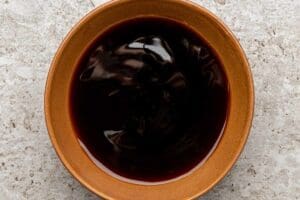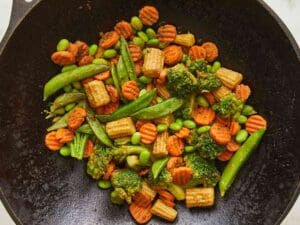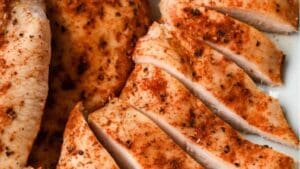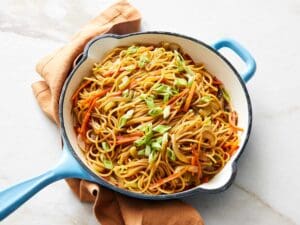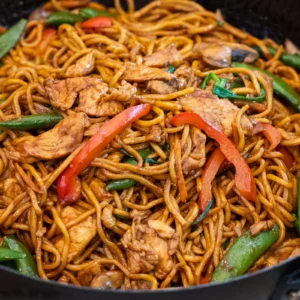Lo Mein is a quick, delicious, and versatile Chinese noodle dish made by stir-frying soft noodles with vegetables, protein, and a savory sauce.
This recipe is an easy way to enjoy takeout-style Lo Mein at home, with options for customizing the protein and veggies to your liking.
Serve it as a main dish or alongside other Chinese-inspired favorites.
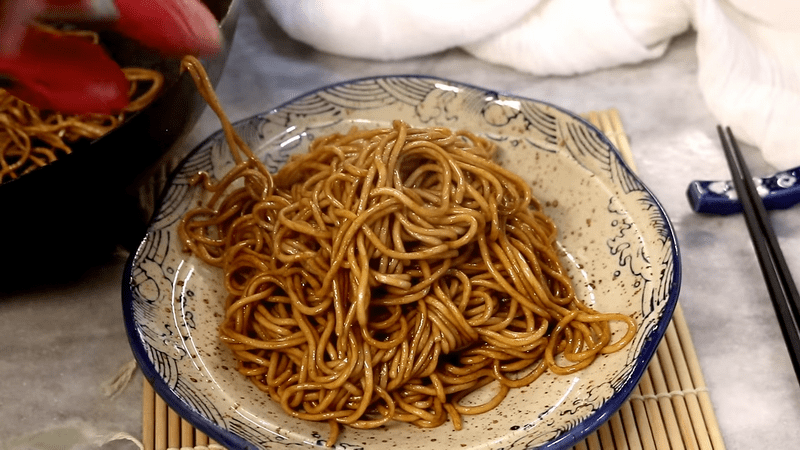
Lo Mein: Quick, Delicious, and Customizable Chinese Noodle Dish
Equipment
- 1 Large pot (for boiling noodles)
- 1 Large skillet or wok
- 1 Small bowl (for sauce mixing)
- 1 Tongs or spatula for stir-frying
- 1 Measuring spoons and cups
Ingredients
Noodles and Protein
- 8 oz Lo Mein noodles 1/2 cup sliced green onions (or spaghetti as a substitute)
- 1 tbsp vegetable oil (or sesame oil for extra flavor)
- 1/2 lb chicken breast thinly sliced (or tofu, shrimp, or beef as alternatives)
- 1/2 cup green onions sliced
Vegetables
- 1 cup mixed vegetables (bell peppers, carrots, snap peas, broccoli)
Sauce Ingredients
- 3 tbsp soy sauce 1/2 tsp minced garlic (or low-sodium soy sauce)
- 1 tbsp oyster sauce
- 1 tbsp hoisin sauce
- 1 tsp sesame oil
- 1 tsp sugar
- 1/4 cup chicken or vegetable broth
- 1/2 tsp grated ginger
- 1/2 tsp minced garlic
Instructions
- Prepare the Noodles:Cook the Lo Mein noodles according to package instructions until al dente. Drain and set aside. If using spaghetti, cook for slightly less time for a firmer texture.Tip: If you can’t find Lo Mein noodles, spaghetti or fettuccine can be great alternatives.
- Prepare the Sauce:In a small bowl, combine the soy sauce, oyster sauce, hoisin sauce, sesame oil, sugar, and broth. Mix well and set aside.
- Stir-Fry the Vegetables:Heat 1 tablespoon of vegetable oil in a large skillet or wok over medium-high heat. Add the ginger and garlic, stir-frying for 30 seconds until fragrant. Then add the mixed vegetables and cook for about 3-4 minutes until they begin to soften.Tip: Try using mushrooms, zucchini, or bok choy for variety.
- Add the Protein:Add the sliced chicken (or your choice of protein) to the skillet, and stir-fry for 3-5 minutes until fully cooked. If using shrimp, cook until they turn pink; for tofu, cook until lightly browned.
- Combine Noodles and Sauce:Add the cooked noodles to the skillet with the vegetables and protein. Pour the sauce over everything, stirring well to coat the noodles and other ingredients evenly.
- Finish and Garnish:Add the sliced green onions, stirring everything together for another minute. Remove from heat and serve hot.
Video
Notes
- Protein Options: Lo Mein can easily be customized with extra protein to make it even more filling. Consider adding a fried or poached egg on top, extra tofu, grilled shrimp, or additional roasted or steamed vegetables.
- Leftover Storage: Leftover Lo Mein can be stored in an airtight container in the fridge for up to 3-4 days.
Reheating Tip: For a quick meal, use the microwave with a few drops of water. Or reheat on the stovetop with a little oil or water to restore texture.
- Freezing Advice: Freezing Lo Mein isn’t ideal as the noodles can become mushy once thawed. However, if necessary, freeze in an airtight container, undercooking the noodles slightly before freezing to help maintain texture upon reheating.
Nutrition
Nutritional Information (per serving)
- Calories: 400
- Carbohydrates: 55g
- Protein: 18g
- Fat: 12g
For All Of You Who Want to Add a Protein Boost…
Lo Mein can easily be customized with extra protein to make it even more filling. Consider adding:
Protein Option
Description
A fried or poached egg
Place a soft, runny egg on top for a creamy, satisfying touch. Break it open, and let the yolk mix in.
Extra tofu or tempeh
For a plant-based protein boost, add more tofu or tempeh, and lightly pan-fried until golden and crispy.
Grilled shrimp or scallops
Lightly seasoned and grilled shrimp or scallops add a delicate, ocean-fresh flavor.
Roasted or steamed vegetables
Add extra roasted or steamed vegetables like broccoli, cauliflower, or zucchini.
How Long Will Leftovers Keep?
View this post on Instagram
Leftover Lo Mein can make a convenient, tasty meal for a few days after you first make it, so it’s perfect if you’re meal-prepping or looking to enjoy it more than once. Typically, these noodles stay fresh in the fridge for about 3-4 days, as long as it’s stored properly.
Place the Lo Mein in an airtight container to prevent it from drying out or absorbing other fridge odors. Keeping it sealed helps preserve the flavor and texture, so you can enjoy it just as much the second time around.
When you’re ready to reheat, you have a couple of options. For a quick meal, the microwave works well—just add a few drops of water before heating, cover it loosely, and warm it in 30-second increments, stirring in between, until heated through.
If you prefer to use the stovetop, heat a skillet over medium heat with a small splash of oil or water, and toss the Lo Mein gently until it’s warmed evenly. The stovetop method can help bring back some of the original texture and flavors, making it taste freshly cooked all over again.
Can You Freeze Lo Mein?

Freezing Lo Mein isn’t ideal because noodles tend to lose their texture and can turn mushy once thawed. The sauce and moisture from the vegetables and proteins can also cause the noodles to become softer than you’d want, making it less enjoyable.
However, if you’ve made too much and don’t want it to go to waste, you can freeze it with a few precautions to preserve as much flavor and texture as possible. When freezing, place the Lo Mein in an airtight container or a freezer-safe bag, removing as much air as possible to prevent freezer burn.
To help the noodles hold up better, try undercooking them slightly before freezing, as they’ll continue to soften upon reheating.
When it’s time to enjoy your frozen Lo Mein, reheat it gently on low heat. Avoid using high heat, as it can lead to uneven reheating and might further soften the noodles.
You can reheat it in a skillet or wok with a splash of water or a little oil to prevent sticking and restore some of the sauce’s consistency. Give it a gentle stir as it heats up, and your Lo Mein should be ready to enjoy again—though it might not be quite as firm as when it was freshly made.
FAQ
Final Thoughts
Once you’ve tried making Lo Mein yourself, you’ll wonder why you ever settled for takeout! Not only do you get to control the ingredients, but it’s also fun to customize the flavors and make the dish truly yours.



